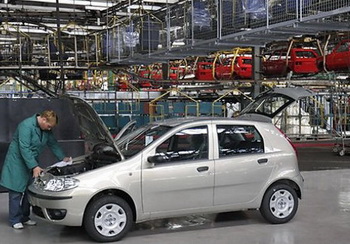 |
|
This week has seen the Punto Classic's range
in Serbia being extended with the arrival of
an LPG version to boost the existing petrol
and diesel engine offerings while at the
same time the first batch of forty-five
petrol-engined cars has headed for the
Serbian-dominated part of Bosnia. |
|
|
|
Fiat
CEO Sergio Marchionne has issued a statement to address the
confusion that has arisen following the unexpected
postponement of Tuesday's signing of the annex to the
existing agreement with the
Serbian government over its future investment into Zastava
Auto. Marchionne says that Fiat still intends to invest in
Zastava but the Serbian company must wait for the completion
of a complete review of the carmaker's European operations
that is following swiftly on the heels of the finalisation
of its plans for Chrysler Group which were publically
announced a week and a half ago. He says that final plans will
be revealed "next month".
"We
continue to work diligently on the development of Fiatís
project in Serbia," Marchionne said in a statement issued in
Turin. "Having completed the assessment of Chryslerís
industrial plan, we are now finalizing the European portion.
The strategic intent which drove our desire to invest in
Serbia has been confirmed. We are now moving quickly to
finalise the determination of the platform allocation to the
plant in Kragujevac, Serbia, which based on our findings to
date, suggests that the output could find multiple
allocations, including Western and Eastern Europe, Russia
and North America. We thank President Tadic and his
administration for the continued support they have provided
and for having shown patience in allowing Fiat to finalise
its findings, which are expected to be announced by the end
of next month," the Fiat CEO concluded.
This week's
non-signing of the appendage to the final agreement is just
the latest twist in a project that has been in a state of
flux for more than a year. Last year Fiat prepared ambitious
plans for Zastava Auto which has had a long association with
Fiat and was at the time was assembling the Punto Classic
(Series 2) under licence, rebadged it for the local market
as the Zastava 10. A Memorandum of Understanding was signed
in April 2008 between Fiat and the Serbian government while
a 700 million euro investment deal was announced on
September 29. The contract called for the Serbian government
to hand over 100 million euros, a 50 million euro loan,
Zastavaís fixed assets, additional land and offer a 10 year
tax exemption, which was valued to the tune of 200 million
euros. As well as Fiat Group Automobiles, Magneti Marelli
and Iveco were both slated to build their own factories in
Kragujuvac. A joint company was incorporated by Fiat and the
government under Serbian law on October 14, 2008.
However the
global financial crisis was already gathering pace by then
and it was hitting carmakers in particular hard as consumers
shunned the showrooms as they felt the effects of the
economic pinch. This caused Fiat to put on hold its
production plans for Serbia and the Punto Classic which had
been jettisoned in mid-November as the factory prepared to
gear up to build two all-new models (a new sub B compact,
referred to as the 'Uno', and a new sub A city car, dubbed
the 'Topolino') was hurriedly put back into production at
the beginning of April. Fiat is lexpected to now invest a
much smaller sum of 200 million euros and build just one
model. The advantage of a Serbian production base is the
cost-saving to be realised from a budding trade agreement
between Serbia and Russia as well as using the location as a
springboard for exporting to the rest of the Balkan region
and Eastern Europe. Meanwhile, this week the Punto Classic's
range in Serbia was extended with the arrival of an LPG
version to boost the existing petrol and diesel engine
offerings while at the same time the first batch of
forty-five petrol-engined cars headed for the
Serbian-dominated part of Bosnia.
|